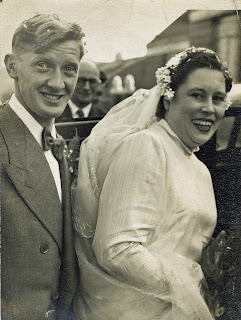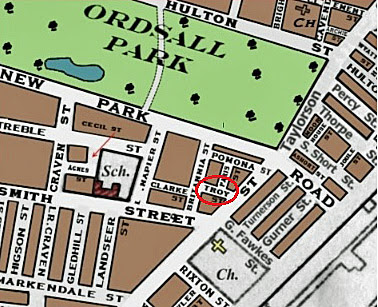John William Cawdery was the son of
George Cawdery and Mary Elizabeth Tricks. He was born in Clerkenwell, London, in
1859.
He (
John Cawdory) appears to have been married twice. First to
Jane Oakley Watkins (1861-) in 1878. The young couple lived on
Walcot Square, Lambeth in
1881, and he worked as a carpenter. This marriage may have ended in divorce in
1887. [
1] "Jenny" Watkins (Mrs. Cawdery) is referred to in the
Preston Herald (3 Feb 1883) where she made her first appearance on stage as "Nan" in the play, Good for Nothing", while John worked as the machinist.
The
1891 census shows John W.
Cawdry living on
Great Titchfield Street in Marylebone with his new wife, Margaret, and the following children:
John's sister, Jane (Mary Jane Cawdery (1857-1929), is living with them.
The
1899 electoral rolls show that John was residing at
67 Prince George Road, Stoke Newington in the Borough of Hackney, and that he had another property located at 98 Orchard Road, West Kensington.
The
1901 census shows that he was living at [30]
Pemberton Road in Harringay with his wife, Margaret Hope Cawdery (
1861-) [
1] of Preston, Lancashire, and their children:
- Lilian born in Preston about 1883/4: a dressmaker's apprentice [?marriage]
- Maggie born in Islington [2] about 1886: a dressmaker's apprentice [marriage]
- Cora born in Islington [3] in 1893 [marriage]
- Frederick A. [4] born in North Kensington about 1898
- William H. R. [5] born in Harringay on 25 July 1900. He died in Brent, Middlesex in 1981.
Their son, John William, does not appear in the 1901 census, and probably died in infancy.
The
1909 electoral rolls show John William
Cowdrey at 94 Netherwood Road, West Kensington.
The
1910 electoral rolls show his address as 6 Richmond Road, Hammersmith
The
1911 census shows that he was living in South Hammersmith.
John
died in 1929 in Brentford at the age of 70.
Like his father and brothers, John William Cawdery was a
Master Carpenter. He also worked as a stage machinist, stage designer and builder, and as an engineer. He was both inventive and entrepreneurial.
1876-77: John Cawdery patents
"The Rolling Wave" [
7], which was used in the final scene of a pantomime at the
Theatre Royal and Opera House in Southampton.
1890 J.W. Cawdery files patent 5818 in Newcastle Upon Tyne for "Improvements in apparatus for working theatrical machinery." (
Shields Daily Gazette Tyne and Wear, 1 May 1890) and patent
5771 "working theatrical scenery".
J. W. Cawdery was responsible for the mechanical effects in the production of the rollicking romantic drama,
Arragh-na-Pogue by the Irish authour, Dion Boucicault. It ran from 29th August to 7th November
1891 at the Royal Princess's Theatre, Oxford Street, London.
1891. J.W. Cawdery appeared in a "weird ghoul-like dance" on stage at the York Easter Pantomime. (Y
orkshire Gazette, 4 Apr 1891)
Cawdery's Patent Switchback Steeplechase, Limited.
 |
| Drawing to illustrate Cawdrey's patent |
In
1894, John filed a
patent for a variation of the
Switchback Railway, which has nothing to do with trains, but was an early form of the modern roller coaster. In essence, John's invention was a mechanical horse racecourse, which became a
popular Victorian amusement.
The course is graded like the course of a switchback railway—with successive hills and valleys to enable a good, but not a dangerous, speed to be kept up (the rider could vary the speed). Each horse runs along a rail, raised above the course on stout upright posts; and when the rider mounts his steed, and is started with a gentle push, the useful force of gravity takes the matter in hand, and sees horse and rider safely to the end of their ride. The Royal Magazine v.8 (1902)
John and his
backers formed Cawdery's Patent Switchback Steeplechase Ltd, in 1896.
Investors were asked to buy stock to the tune of
£60,000, The first "Gravity Steeplechase Racecourse" was built in the grounds of
Alexandra Palace, London. Plans were also made to install a racecourse at a proposed
Swaneries Marine Park at Southend-on-Sea, and another at
Brighton. The company was
dissolved in 1902.[
6] The patent was eventually sold to
George Tilyou, an American,
 |
| Gravity Steeplechase at Alexandra Park, London |
who built a racecourse as the centerpiece of his amusement park at
Coney Island, New York.
- 1897: The building of the Alexandra Theatre and Opera House, Stoke Newington. "The stage, which is a very large one, is fitted with the latest improvements, and is capable of staging the biggest productions or the heaviest of pantomimes, has been laid under the experienced direction of Mr J. W. Cawdery."
- 1898: The rebuilding of the Dalston Theatre, Hackney. "The stage is of a size capable of taking any production, with a proscenium opening of great width, and has been fitted up by Messrs Cawdery and Co."
- 1898: Construction of the Grand Theatre, Luton. The stage was fitted out (with all the latest improvements) by Mr J. W. Cawdery of London.
- 1922: International theatre exhibition : designs and models for the modern stage, held at the Victoria & Albert Museum. The half-scale model of the theatre of the Royal Academy of Dramatic Arts, Bloomsbury. J. W. Cawdery & Co. built the stage model.
- 1929: During the construction of the Streatham Hill Theatre, "Cawdery's Theatre Service" was hired as a consultant on the building's stageworks.
Live performances were gradually being challenged by the growing number of movie cinemas being introduced in the early decades of the twentieth century, and many theatres were converted to cinemas over time. John tried to keep abreast of these changes. In the trade publication, The Era (4 Dec 1922), we see him advertising
J. W. CAWDERY CO. THEATRICAL AND KINEMA CONTRACTORS
Around this time, he became interested in acoustics (The Era 14 Dec 1922) as the new medium of film began to experiment with sound. In this particular issue, he advertised "our patent Kinema Frame".
John patented a cinema screen that could be raised and lowered using a system of pulleys and counter weights, which could be operated by "one man only". He filed the patent on June 12, 1923.
 |
Drawing to illustrate patent 220,412
"Improvements in or relating to optical projection screen and also the method of lowering and rasing same" |
On 14 March 1919, John filed a
patent entitled "Improvements in Parachutes". At the time, he was living at 150 Sinclair Road, West Kensington. It is acknowledged [
8] that his invention represents an important milestone in the development of parachutes, because it allowed the parachutist to steer the chute by using guidelines attached to lateral flaps in the canopy.
 |
| Drawing to illustrate Cawdery's improved parachute |
Of Interest
Video:
Victorian stage machinery
Notes
[1]
Margaret Hope Lancaster: married in
Wharfdale, Yorkshire in 1888. The date and the registration of their first born as Lilian Cawdery
Lancaster suggests the first two children were born out of wedlock. The Cawdery - Lancaster marriage may not have been possible until the Cawdery-Watkins marriage had been
dissolved.
[2] The
1911 census records
Tilington as Maggie's birthplace. This is probably a transcription error for Islington..
[3] The
1911 census records Tilington as Cora's birthplace. .
[4]
Frederick Alexander Cawdery born in West Kensington.
[5]
William Henry [Redvase] Cawdery
[6] J. W. Cawdery & Co., Palatine Works, Palatine Road, Stoke Newington and of 30 Pemberton Road, Harringay, was a firm described as a "builder and theatrical contractor". It also filed
bankruptcy in 1902. (
Law Times). It appears that this was a company separate from the Steeplechase venture, and may have been a financial casualty of the latter's demise. Some sources erroneously call him James William Cawdery.
[7] I do not know the exact nature of the 'Rolling Wave' but it may have looked like this.
[8] See Matthews ; US Forest Service ;
































